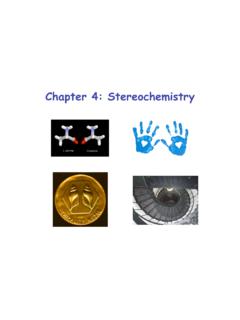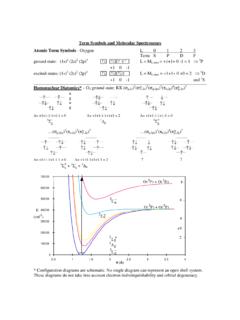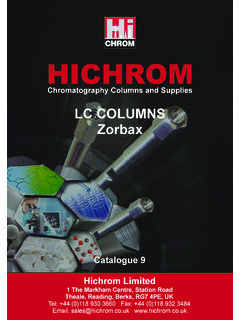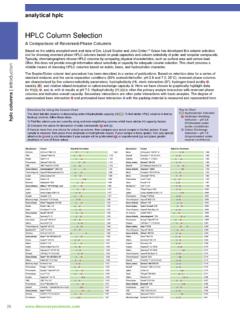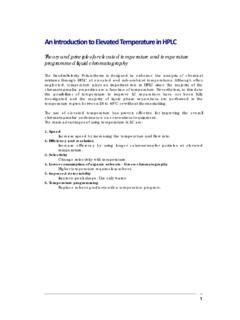Transcription of Capillary HPLC Introduction Capillary HPLC - Colby College
1 Capillary hplc Introduction z Capillary hplc . Liquid chromatography/mass spectrometry, LC/MS, is a revolutionary tool in the chemical and life sciences. LC/MS is accelerating chemical research by providing a robust separations and identification tool for chemists and biologists in diverse fields. LC/MS is best done with Capillary hplc . Capillary hplc uses smaller column internal diameters than conventional hplc . Smaller ID columns , for fixed amounts of injected material, produce taller peaks. Taller peaks provide better detection limits for mass spectrometry and other concentration sensitive detectors. For the same amount of material injected, the peak height is inversely proportional to the cross sectional area of the column. The use of smaller ID columns requires careful planning if you are used to normal mm columns .
2 This General Introduction to Capillary hplc is designed to provide a practical survey of the day-to-day issues in solving chemical problems using hplc and to give you the necessary information to use the Agilent 1100 Capillary hplc and Ion Trap SL. Sufficient theory is provided so that you will know why you are doing the things you do. You may not personally use all the material in this tutorial, but knowledge of what others are doing with the instrument will be helpful in solving problems that may arise due to previous users. Electrospray mass spectrometry places particular requirements on hplc separations. We begin with a short Introduction to electrospray mass spectrometry so that the requirements for MS. detection are clear at the outset. z Electrospray Ion Source The most common detector for hplc is a UV detector.
3 However, a mass spectrometer provides a means of identifying the components in different peaks. MS is a very powerful tool, but your hplc method and sample preparation must be carefully designed to achieve good detection limits. The key to using MS as a detector is the ability to transfer your analytes into the vacuum of the mass spectrometer as ionic species. This process is handled by an electrospray ion source in our instrument. Electrospray ion sources are soft ionization sources, that is they produce mostly protonated molecular ions, MH+. The proton transfer can occur in your solution or in the droplets produced by the electrospray source. M + H+ -> MH+. pH control for the hplc mobile phase can have a strong effect on the ionization. As a consequence, hplc eluants for electrospray MS usually are buffered or have added acids to enhance and control the formation of ions.
4 Buffer Additives: Because of the need to control ion formation, buffers are very common in LC/MS. However, standard buffers like Tris, HEPES, and phosphate buffers are non-volatile and can clog the MS inlet Capillary . Therefore, non-volatile eluant additives are necessary. The most common buffer components are formic acid, trifluoroacetic acid, acetic acid, ammonium formate, ammonium acetate, and heptafluorobutyric acid (in that order). For more basic buffers, 10-20 mM tetraethylammonium formate or bicarbonate is common. Often compromises in buffering capacity are made by choosing one of these volatile buffer components. Trifluoroacetic acid can suppress ion formation in electrospray, so its concentration is usually kept < z MS and MS/MS. Electrospray is a soft ionization technique.
5 Electrospray spectra are very simple and molecular weights are easy to determine from the MH+ parent peaks. Electron ionization, EI, produces fragment rich spectra. The fragment ions are useful to help determine the structure of the compound. On the other hand, in EI some classes of compounds don't produce intense parent peaks, so the molecular weight is difficult to determine. While the ease of molecular weight determination is a strength for electrospray, the lack of structural information from fragment ions can be a draw back. MS/MS techniques can solve this problem. In MS/MS analysis, the MH+ ions formed from the electrospray source are fragmented by adding extra collisional energy. MS/MS spectra are very similar to EI spectra and can be interpreted in the same way. The important parameter for MS/MS based analysis in LC/MS, is that MS/MS takes extra time.
6 If the eluting peaks are too narrow, then there won't be time for MS/MS analysis. As a consequence, some compromise in resolution and retention time may be necessary to do auto MS/MS analysis. Strangely, this means that the best efficiency isn't always best for MS/MS. detection, which is a strange circumstance for most chromatographers. Capillary hplc . The following sections discuss reversed phase hplc in general terms and focus on the issues that are particularly important for Capillary hplc /MS. Please see a text on hplc for more complete discussions of chromatography principles. A separate tutorial is available for ion exchange, HILIC, HIC, and size exclusion modes. z Reversed Phase Chromatography, RP. In reversed phase separations the analyte partitions between a hydrophobic stationary phase and a polar mobile phase.
7 Typical reversed phase stationary phases are based on C18 hydrocarbon chains attached to silica particles through silyl-ether bonds: Si-O-CH2-R. The mobile phase usually consists of acetonitrile-water mixtures or methanol-water mixtures. Reversed phase chromatography is useful for a range of analytes from moderately polar to rather hydrophobic. Reversed phase is the most common mode for hplc , because it is the most versatile and the easiest to do. z Eluants Acetonitrile-water and methanol-water mixtures are the most common eluants for reversed phase hplc . The non-aqueous component is called the organic modifier. The Solvent Properties table below is very useful for selecting the organic modifier. Reversed phase columns always need some water, so water miscibility is necessary. The other solvents may be useful for wash solvents.
8 The table gives the solvent strength for many of the common solvents used in hplc . The polarity and the solvent strength parameter, p, can be used to pick the organic component for your mobile phase. Lower p values correspond to stronger solvents for reversed phase chromatography. For example, acetonitrile is a stronger solvent for non-polar organics than methanol. Acetonitrile is therefore the most common organic modifier, followed by methanol. 2-Propanol can also be used as a modifer, however, its much higher viscosity produces higher backpressures and requires the use of shorter columns . The UV. cut off determines the wavelength range usable for UV/Visible detectors; see the discussion under Detectors below. You also minimize baseline changes by matching the modifier refractive index with that of water.
9 Big mismatches make the baseline more composition and temperature sensitive. Solvent properties for Organic Solvents Commonly Used in hplc in order of increasing polarity Solvent Polarity Miscible with UV cut off Refractive Solvent Viscosity water? Index 20 C Strength o 20 C, cp Hexane nonpolar no 200 Isooctane no 200 Carbon tetrachloride no 263 Chloroform no 245 Methylene chloride no 235 Tetrahydrofuran no 215 Diethyl ether poorly 215 Acetone yes 330 Ethyl acetate yes 260 Dioxane yes 215 Acetonitrile yes 190 2-Propanol yes 210 Methanol yes 205 Water polar yes - > In summary, always start with acetonitrile as the modifier. Test your sample to find the range of acetonitirle-water compositions over which your sample is soluble. If a more polar modifier or a modifier that can hydrogen bond is useful, next try methanol.
10 Many analytes are acids and bases. The charge state of acids and bases are strongly dependent on pH. A neutral molecule typically has much longer RP retention times than an anion or cation, therefore the reproducibility of retention times of acids and bases depend strongly on pH. It is then recommended to always buffer the mobile phase. Eluants with ammonium acetate or phosphates are like ringing the dinner bell for bacteria. These buffers can go bad in just a few days if they have less than 20% acetonitrile or methanol. Therefore, highly aqueous mobile phases should always be made up fresh, just before you start. Always refrigerate acetate and phosphate aqueous buffers. Acetate Ringing the dinner bell for bacteria! Isocratic verses Gradient Elution In an isocratic separation the composition of the mobile phase remains constant.

